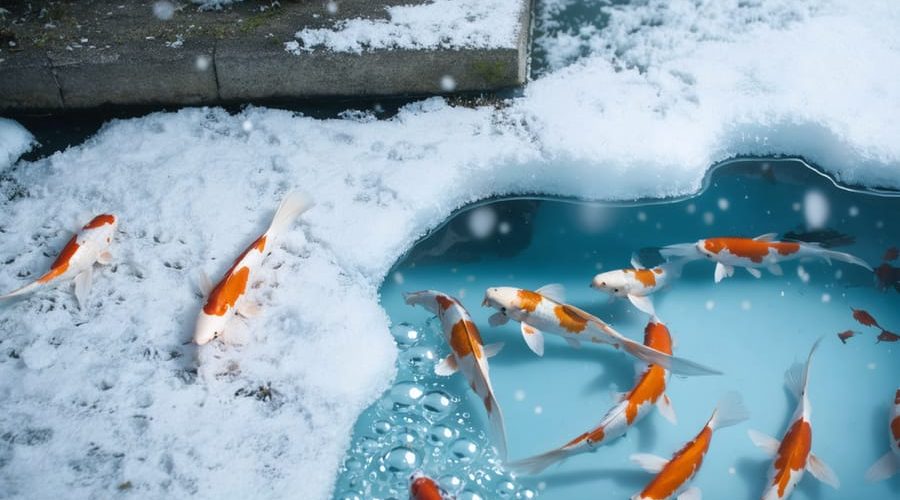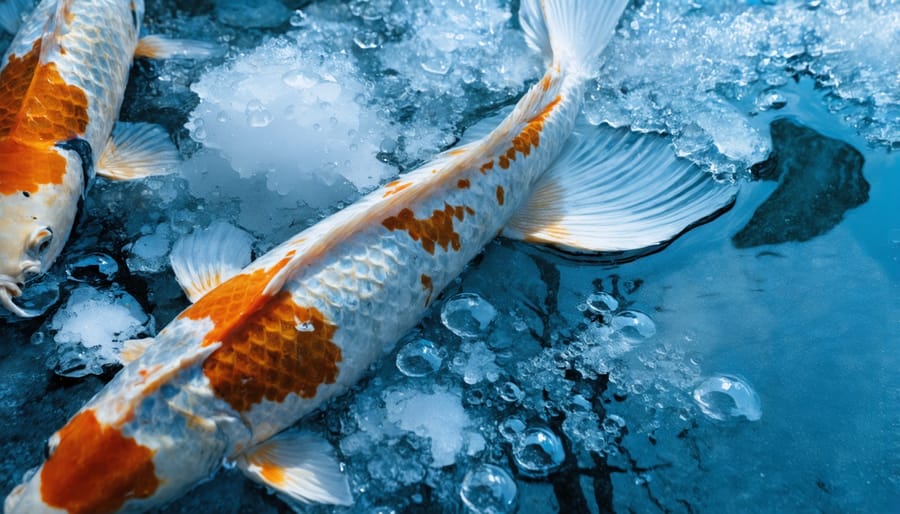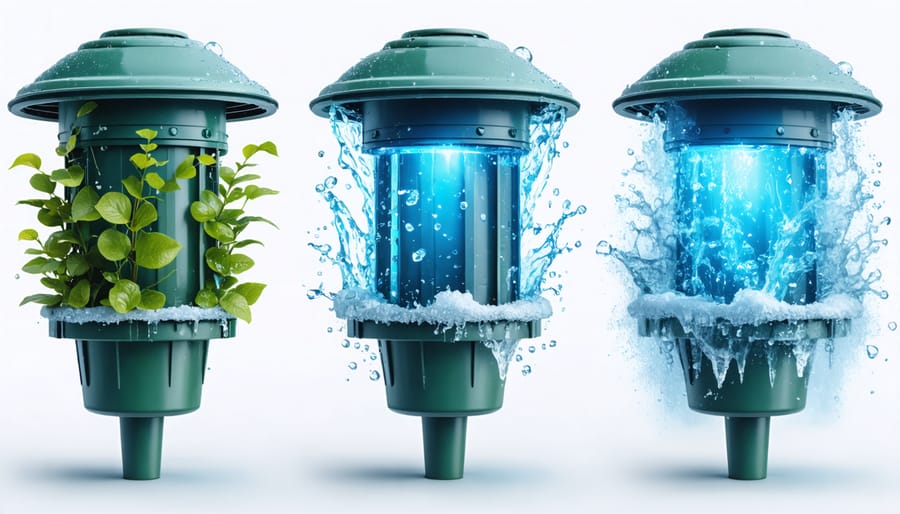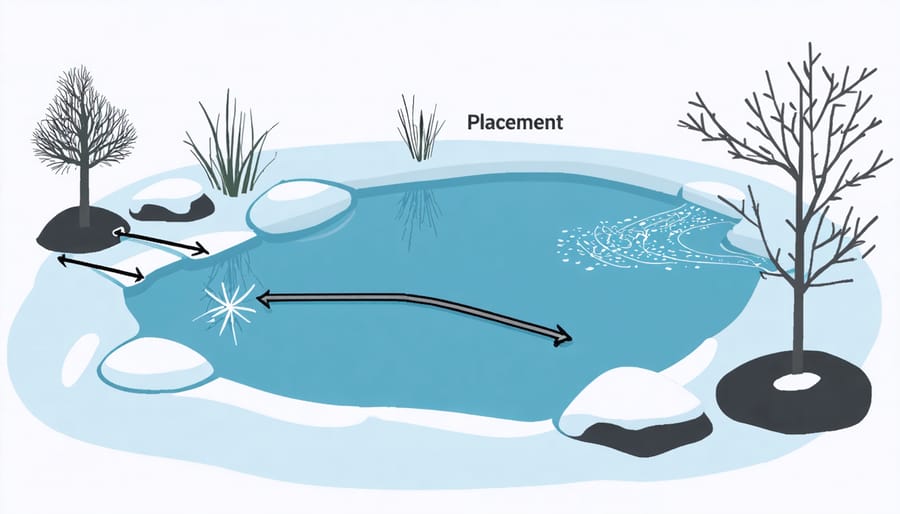
Why Your Koi Need More Than Just a De-icer This Winter
Protecting your koi pond during winter requires more than just preventing ice formation – it’s about maintaining a delicate balance of oxygen and harmful gases that can trap your fish. A reliable de-icer serves as your pond’s winter lifeline, creating vital breathing holes that prevent toxic gas buildup while keeping your precious koi safe from freezing temperatures. Without proper de-icing, even the healthiest pond can quickly become dangerous for its inhabitants when ice seals the surface completely.
Unlike simple bubbler systems, quality pond de-icers maintain consistent open areas that allow proper gas exchange throughout the coldest months. They work silently around the clock, using thermostat-controlled heating elements to keep a portion of your pond’s surface free from ice – even when temperatures plummet well below freezing. Whether you’re a seasoned koi keeper or new to winter pond management, understanding how to choose and use the right de-icer can mean the difference between thriving fish and winter casualties.
The Winter CO2 Challenge in Koi Ponds
Understanding Gas Exchange in Winter
During winter, when ice covers your pond, a delicate balance of gas exchange becomes crucial for your koi’s survival. Think of the ice layer as a lid that traps gases beneath it. While fish continue to breathe, they release carbon dioxide (CO2) into the water. Without proper gas exchange, this CO2 builds up while oxygen levels decrease – a potentially dangerous situation for your pond inhabitants.
In a natural setting, gases constantly move between the water and air. However, when ice forms a complete seal over your pond, this vital exchange is blocked. That’s why creating an opening in the ice is so important. It’s not just about preventing the pond from freezing solid; it’s about maintaining healthy oxygen levels and allowing harmful gases to escape.
The good news is that koi’s metabolism slows significantly in cold water, meaning they need less oxygen. Still, ensuring proper gas exchange through winter is essential for their health and survival.

The Hidden Dangers of CO2 Buildup
During winter, when ice forms on your pond’s surface, a dangerous situation can develop beneath. While CO2 levels in ponds are typically balanced through natural gas exchange, ice cover can disrupt this process. As your koi continue to breathe, they produce CO2 that becomes trapped under the ice, leading to a buildup of this harmful gas.
This excess CO2 can cause several problems for your fish. It makes it harder for them to absorb oxygen from the water and can create a more acidic environment, stressing their immune systems. Over time, high CO2 levels can lead to lethargy, loss of appetite, and even serious health issues in your koi.
Using a de-icer isn’t just about preventing your pond from freezing solid – it’s about maintaining that crucial gas exchange. By keeping a portion of the surface ice-free, you’re allowing CO2 to escape and fresh oxygen to enter, creating a healthier winter environment for your fish.
De-icers as Part of Your Winter Strategy

Types of De-icers and Their Effectiveness
When it comes to keeping your koi pond ice-free during winter, you’ve got several reliable options to choose from. The most popular type is the floating de-icer, which sits on the water’s surface and maintains a small ice-free area. These are energy-efficient and easy to install, making them perfect for most backyard ponds.
Submersible de-icers offer another excellent solution, resting at the bottom of your pond and creating a column of warm water that rises to the surface. While they’re typically more powerful than floating models, they do consume more electricity.
For larger ponds, pond aerators with built-in de-icing capabilities provide a dual benefit: they prevent ice formation while maintaining healthy oxygen levels. Though more expensive initially, they’re incredibly effective and energy-efficient in the long run.
Infrared heat lamps are less common but can work well for small ponds. They warm the water from above but should be carefully positioned to prevent overheating.
Remember, the best de-icer for your pond depends on its size, depth, and your local climate. Consider a combination of methods for maximum effectiveness during particularly harsh winters.
Optimal De-icer Placement for CO2 Release
Proper placement of your pond de-icer is crucial for effective CO2 release during winter months. The best spot is typically near the pond’s edge, where water is at least 18-24 inches deep. This depth ensures the device stays submerged while creating an optimal opening in the ice for gas exchange.
Position your de-icer away from waterfalls or fountains if you keep them running, as you’ll want multiple oxygen exchange points across your pond’s surface. For larger ponds, consider placing the de-icer in an area where fish tend to gather during winter, often in deeper sections.
A helpful tip is to mark your de-icer’s location with a floating marker or tie a brightly colored cord to it before ice forms. This makes it easier to check on the device throughout winter and ensures you can find it when spring arrives.
Remember to keep the de-icer away from pond liner edges and underwater plants to prevent any accidental damage. The goal is to create a small, consistent opening that allows toxic gases to escape while maintaining your pond’s overall winter insulation.
Creating a Complete Winter Gas Management System
Combining Aeration with De-icers
For optimal winter pond care, combining a de-icer with natural pond aeration creates a powerful duo that keeps your koi healthy and happy. While a de-icer maintains an ice-free opening, an aerator circulates the water and provides essential oxygen throughout the pond.
To set up this winning combination, place your aerator diffuser about 18 inches below the surface, away from the deepest part where your koi rest. Position your de-icer nearby to work together with the rising air bubbles, creating a larger ice-free zone while using less energy. The moving water from the aerator helps prevent ice formation, allowing your de-icer to work more efficiently.
During particularly cold spells, you might notice the aerator’s bubbles creating a dome of ice above the diffuser. Don’t worry – this is normal and still allows for gas exchange. Just ensure your de-icer maintains a separate opening for additional safety.
Remember to adjust your aerator’s output during winter – you want gentle circulation, not a turbulent current that disturbs your resting koi. A timer can help manage both devices, running them intermittently to save energy while maintaining safe conditions. This partnership not only keeps your pond healthy but also provides peace of mind throughout the winter months.

Monitoring and Maintaining Healthy CO2 Levels
During winter, monitoring CO2 levels becomes crucial when using a de-icer, as ice coverage can affect gas exchange in your pond. A simple way to check CO2 levels is by observing your koi’s behavior – if they’re swimming near the surface and appearing to gasp, this could indicate high CO2 levels. Regular testing with a quality water testing kit is essential for maintaining healthy pond chemistry.
To keep CO2 levels in check, ensure your de-icer maintains an adequate opening in the ice, typically about 1 square foot per 100 square feet of pond surface. This opening allows for proper gas exchange. Consider adding an air pump or bubble stone near the de-icer to enhance circulation and help release trapped CO2.
Remember to check the opening daily during freezing temperatures. If you notice ice building up around the edges of the hole, adjust your de-icer’s position or consider adding a second unit. Keep snow cleared from the ice surface around the opening to allow sunlight penetration, which helps with natural CO2 regulation.
Don’t forget that plants, even in their dormant winter state, can help regulate CO2 levels. While they’re less active, maintaining any winter-hardy aquatic plants can provide additional support in managing gas levels.
Simple Maintenance Steps for Winter Success
Keeping your pond de-icer running smoothly throughout winter doesn’t have to be complicated. Here’s your simple maintenance checklist to ensure your system works effectively all season long:
Check your de-icer daily to ensure it’s functioning properly and hasn’t been displaced by ice formation. A quick visual inspection can prevent bigger problems down the line. Remove any debris, leaves, or ice buildup that might affect its performance.
Keep the power cord protected and elevated above the water level to prevent it from freezing into the ice. Consider using a cord protector or securing it properly to avoid damage from wildlife or weather conditions.
Clean the heating element monthly using a soft brush and mild vinegar solution to remove mineral deposits. This simple step helps maintain optimal heat transfer and extends your de-icer’s lifespan.
Monitor your pond’s water level regularly, as winter evaporation can still occur. Low water levels can affect your de-icer’s performance and potentially damage the unit. Top up when needed, but avoid adding large amounts of cold water at once.
Test your GFCI outlet weekly by pressing the test button and ensuring it trips properly. This safety check is crucial for preventing electrical hazards during wet winter conditions.
Consider installing a backup power source or having a spare de-icer on hand. Winter storms can cause power outages, and having a backup plan helps protect your pond inhabitants during critical times.
Remember to maintain a consistent maintenance schedule. Set reminders on your phone or calendar to ensure you don’t miss important checks during the busy holiday season.
Maintaining your koi pond during winter requires a comprehensive approach, with de-icers playing a crucial role in your fish’s survival and well-being. By keeping a portion of your pond’s surface free from ice, you’re not just preventing freezing – you’re ensuring proper gas exchange, protecting your beloved koi, and maintaining the delicate balance of your pond’s ecosystem.
Remember that a de-icer works best when combined with other winter maintenance practices. Regular monitoring of water temperature, maintaining proper depth, and ensuring adequate oxygen levels are all essential components of winter pond care. If you’re using a floating de-icer, check it periodically to ensure it’s functioning correctly and hasn’t become frozen into the ice.
As winter approaches, take time to prepare your pond properly. Install your de-icer before the first freeze, reduce feeding as temperatures drop, and consider adding cold-water beneficial bacteria to help maintain water quality. With proper planning and the right equipment, your koi can thrive even during the coldest months, emerging healthy and vibrant when spring arrives.
Your dedication to winter pond maintenance will reward you with healthy, happy koi year after year, making all your efforts worthwhile.
